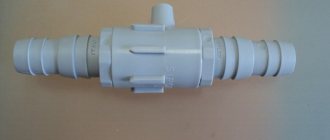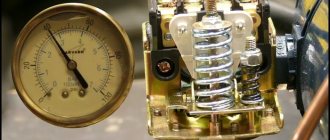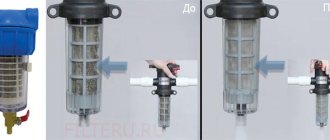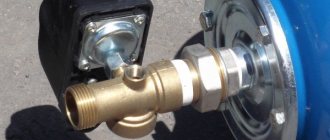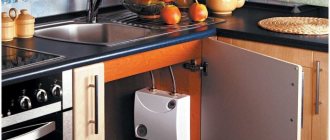Overheating of the coolant leads to its strong expansion, especially if the temperature has reached the boiling point. When the coolant expands, the pressure in the system rises, which can lead to serious consequences: from slight leakage of connections or failure of heating system components, to rupture of lines in inaccessible places (walls or under floor screed).
A well-known way to prevent the destruction of a heating system due to high pressure is a safety relief valve. In the article we will look in detail at its design and operating principle, define the criteria for choosing a mechanism, the installation algorithm in the heating system, as well as actions in a situation if the pressure relief valve has leaked.
What it is?
A dry technical definition says: an overpressure valve is a fitting that automatically releases excess water when excess pressure occurs.
It is a direct-acting device because it reacts directly to the influence of a heated medium (water or other coolant).
As a rule, an overpressure valve is included in the basic package of all compact water heating devices.
Sometimes an overpressure valve is confused with a check valve. Often both devices are placed in a single housing, which is why confusion arises. However, these devices are used to perform different tasks and are fundamentally different from each other .
Operating principle
Most ordinary users faced with closed water heating systems are familiar with only one type of safety valve - a simple spring valve with a fixed setting, shown in the photo. The reason is clear - these elements are installed everywhere on any boilers, since they are part of the safety group along with a pressure gauge and an air vent.
Note. Wall-mounted heat generators operating on electricity and natural gas are equipped with safety elements from the factory. They are placed inside the case and are not visible from the outside.
Let's understand how a regular emergency valve works, shown in the diagram above:
- Under normal conditions, the diaphragm, attached to the stem and supported by a spring, sits tightly in the seat and seals the passage.
- If the coolant overheats, it expands and creates excess pressure in a closed system, partially compensated by the expansion tank.
- When the amount of water pressure reaches the valve response threshold (usually 3 Bar), the spring is compressed under its influence and the membrane opens the passage. The boiling coolant is automatically discharged until the spring has enough strength to close the flow area again.
- In the event of an emergency, the owner of the house can relieve excess pressure himself by turning the handle at the top of the product.
A few words about where the relief valve is installed along with the safety group in a closed heating system. Its place is on the supply line in the immediate vicinity of the boiler (recommended no further than 0.5 m).
The safety unit is always installed on the heater flow line
Important point. It is prohibited to install taps, valves and other shut-off devices on the pipeline leading from the heat generator to the safety elements.
You should not tightly connect the pipe of the product to the sewer - wet spots or puddles will indicate the valve has been activated and problems in the heating network. For example, the expansion tank failed or the circulation pump malfunctioned when working with a solid fuel boiler (the electricity may have been turned off). Often the device begins to leak due to debris getting between the seat and the plate. More about his work is described in the video:
Watch this video on YouTube
Additional information. Masters and installers call spring relief valves blasting valves because the pressure of the coolant compresses the spring and causes the membrane to explode. Do not confuse them with explosive elements installed on the chimneys of industrial boiler houses that burn natural gas.
What is it needed for?
The function of the valve is to discharge excess hot water in the working tank of the heater. The expansion of water creates high pressure, threatening the integrity of the device.
The valve automatically drains a certain amount of water, bringing the total volume to the nominal value. This allows you to preserve the heater, protect equipment and people from contact with hot water.
Excess volumes of water are discharged through a special pipe connected to a drainage system or a special receiving tank.
Design of safety valves
Depending on the operating conditions and purpose of the valve, they may differ in a number of parameters: standard size;
- body material (cast iron, bronze);
- material of the shut-off membrane (natural rubber, reinforced nitrile rubber);
- type of connection to the body (flange, threaded, quick-release-victaulik);
The design orientation of the rod and diaphragm can be:
- vertical – equipment of series 100 and 300;
- inclined – series 500.
Consequences of absence
When heated, the liquid increases its volume (expands) by 3% .
This means that a heater with a working volume of 10 liters will have an additional 0.3 liters. If the container is not sized to accommodate additional volumes of water (and this is most often the case), the heater body will be destroyed. Then a crack will appear into which water will begin to leak.
Most heaters are designed in such a way that a decrease in pressure in the working tank is immediately compensated by replenishment from the network. Therefore, the leak will be constant until the container is replaced or repaired .
Design and principle of operation
The overpressure valve is a direct acting spring valve. Its outlet pipe is blocked by a ball pressed to the hole by a spring.
When the H2O pressure in the heater exceeds the spring force, the ball opens the passage and releases excess water. As soon as the pressure drops, the spring presses the ball again and closes the outlet.
There are different designs of valves, where not only a ball, but also a wedge, a disc element, and other parts are used as a locking mechanism. However, the general principle of operation is the same for all designs.
Externally, the valve resembles a regular tee fitting, but a water release handle is installed on its perpendicular outlet. The outlet pipe is equipped with ribbed projections for attaching a tube connecting to the drainage system.
Connection type
Based on the type of connection or connection to the pipeline, valves are divided into:
- flanged products - equipped with flange plates at each outlet and connected to mating flanges at the ends of the pipes using bolts;
- threaded - imply the presence of outlet pipes with external threads;
- welded - attached to the gas pipeline by welding and ensure 100% tightness.
Kinds
There are several types of such devices . First of all, they are divided according to the maximum pressure:
- for containers up to 50 l;
- from 50 to 200 l;
- above 200 l.
As a rule, devices of the first and second groups are one-piece. More powerful safety valves are designed to work with high pressure (usually up to 7 bar).
There are models with and without release handle. The first ones are more convenient; they allow you to check the functionality of the device or manually reduce the amount of water in the container.
Installation Rules
In closed heating systems, the safety valve is installed at the highest point of the supply circuit.
There should not be any functional elements (valves, valves, gate valves) between it and the boiler. A mandatory requirement for installing the device is a strictly vertical position. Installation even at a slight angle will result in water leakage.
A discharge hose is connected to the valve's discharge pipe, which is directed into the sewer. It is advisable to choose a location for installing the device to ensure easy access to it in case of need for maintenance or replacement.
How to choose a model for a boiler?
If your water heater is equipped with a safety valve as standard, you must purchase the same model to replace it. However, sometimes situations arise when it is necessary to install the device on an old boiler model that is not equipped with such protection.
In such cases, it is customary to be guided by the color of the release handle:
- red color - the model is designed for a maximum pressure of 0.6 MPa;
- black color - 0.7 mPa;
- blue color - 0.8 mPa.
The boiler parameters can be found in the instructions. Sometimes the maximum pressure is indicated on a special plate or paper sticker mounted on the body of the device.
It is necessary to select a device in strict accordance with the upcoming load . If it is designed for less pressure, the water will constantly drain. If the valve rating is much higher than the operating value, the device will not operate if overloaded, creating a danger for the heater.
Step-by-step installation instructions
An overpressure valve is installed on the cold water supply line to the water heater. There should be no additional devices or shut-off valves between the boiler and the device.
An arrow on the device body shows the direction of water to eliminate installation errors.
Tools and materials
For installation you will need:
- FUM tape or sanitary linen;
- transparent tube for the outlet pipe;
- gas key (small).
Winding is needed to seal threaded connections. You must use the gas wrench carefully so as not to strip the thread or tear off the pipe on the boiler.
A transparent tube is pulled over the outlet pipe, and the other end is placed in the sewer outlet . The tube does not have to be transparent, but it is more convenient to control the draining process if you can see the mode of discharge of excess water.
Installation process
Before starting installation, you must turn off the power supply to the boiler, drain the water and turn off the supply tap.
The valve device is usually screwed directly to the heater feed pipe . Plumbing flax or FUM tape is applied to the threaded connections, after which the valve body is screwed on.
The outlet pipe must point downwards. Then the flexible supply hose is screwed on and the water drain tube is pulled.
To check the functionality of the protection, pour water and turn on the heating. When the device reaches the nominal mode, the drain handle is set to a vertical position. If water flows from the pipe (it can be seen through the transparent walls of the tube), it means that the installation was completed correctly.
Expert advice
- A blasting device with standard technical characteristics allows water to pass through even at low pressure levels when clogged. The problem can be solved by cleaning the body parts. To do this, the product must be dismantled and placed in a container with vinegar for 2 - 3 hours. Then rinse it with water until completely clean and install it in its original place, lubricating the connection area with alcohol.
- If the valve continues to leak even after cleaning, then most likely the rubber gasket resting on the seat is clogged with debris. It is easier to replace such a part than to clean it without deformation. Replacing the valve on the supply pipeline to the boiler can be seen in the video:
- A number of consumers quite reasonably doubt the durability of shut-off valves with plastic parts. They actually have a shorter service life, so it’s better to immediately buy ones with metal components. Such products are on average 100 - 150 rubles more expensive, but they last much longer.
- You cannot simply turn off the device, even if it is leaking. A huge number of heating boilers have failed precisely after installing the plug.
Problems: their causes and solutions
There are two types of problems possible:
- Constant leakage from the outlet pipe. This indicates excess pressure in the water supply system. The problem is solved by installing a gearbox.
- No release of excess water at high pressure in the tank. This means that the valve is damaged or is designed for higher pressure. In any case, the device must be replaced by selecting a model that is suitable for its nominal value.
It is necessary to periodically check the functionality of the device. Replacing it will cost much less than repairing or buying a new boiler.
The video will tell you what to do if there is a leak from the safety valve from the water heater:
Functions
Safety valves for water supply and heating systems prevent pressure from rising above their activation level and protect pipelines, fittings and other fittings from damage.
It is worth clarifying: they are not used in cold water supply systems, centralized hot water supply systems with water supplied from heating mains and central heating. Club members - hot water supply with water preparation in a storage water heater (electric boiler or indirect) and autonomous heating.
DHW circuit with indirectly heated storage water heater
DHW
Any type of storage water heater must be equipped with a check valve at the inlet.
Why?
Yes, simply because without this valve, water will pour out of the boiler when the main water supply is turned off and reset. You see, its inlet pipe opens into the tank just above the bottom level: such a device allows you to achieve stratification of water according to temperature.
Electric boiler design diagram
Please note: in addition to financial costs, discharging water from the tank will mean a high probability of leakage from the heating elements of the electric boiler.
Now imagine what will happen after filling and turning on the boiler, separated from the cold water supply by a check valve.
- The water temperature will begin to rise;
- As it heats up, its volume will begin to increase, in full accordance with the laws of physics;
Volume growth when water is heated
- An increase in the volume of almost incompressible liquid in the confined space of the tank will cause a rapid increase in pressure.
This is where the safety valve installed on the water supply comes to the rescue: it will release excess water into the drainage and thereby reduce the pressure level.
Heating
On heating, our hero is part of the boiler safety group and performs the same function as on hot water supply: it releases part of the coolant when the pressure rises dangerously.
The valve works in tandem with a membrane expansion tank and duplicates its functions: in normal mode, the excess coolant is contained in the expansion tank by compressing the air separated from the water by an elastic membrane. If the pressure continues to rise due to incorrect calculation of the volume of the tank or overheating of the coolant, the valve is triggered.
Solid fuel boiler piping
By the way: installing an expansion tank is also practiced with boilers of significant volume. It significantly reduces water supply costs: without an expansion tank, each time the water in a 300-liter indirect tank is heated from 10 to 70 degrees Celsius, a little over 6 liters of hot water will be drained into the drain.
Tank in the indirect harness
